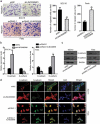LINC00958 regulated miR-627-5p/YBX2 axis to facilitate cell proliferation and migration in oral squamous cell carcinoma
- PMID: 31161900
- PMCID: PMC6741574
- DOI: 10.1080/15384047.2019.1617571
LINC00958 regulated miR-627-5p/YBX2 axis to facilitate cell proliferation and migration in oral squamous cell carcinoma
Abstract
Oral squamous cell carcinoma (OSCC), the subtype of head and neck cancers, is notorious for its high incidence and death rate. The role of long non-coding RNAs (lncRNAs) is discovered to be significant for the canceration and cancer progression. Long intergenic non-protein coding RNA 958 (LINC00958) is discovered as a carcinogene in multiple cancers, such as gastric cancer, pancreatic cancer, and glioma, but there has been no report about how LINC00958 functions in OSCC. The objective of our study is to unfold function and mechanism investigation on LINC00958 in OSCC. First, TCGA database showed the upregulation and prognostic significance of LINC00958 in head and neck squamous carcinoma. Then, we discovered in OSCC clinical samples that LINC00958 presented high expression and predicted poor prognosis. Also, LINC00958 was elevated in OSCC cells. In vitro gain- and loss-function experiments proved that LINC00958 facilitated cell growth, retarded apoptosis, accelerated migration, and epithelial-to-mesenchymal transition (EMT) in OSCC. Mechanistically, we confirmed the cytoplasmic expression of LINC00958 in OSCC cells, and revealed that LINC00958 sequestered miR-627-5p to upregulate YBX2 expression. Rescue assays indicated that LINC00958 regulated OSCC cell proliferation, motility and EMT through YBX2. Together, we showed that LINC00958 promoted OSCC progression through miR-627-5p/YBX2 axis, indicating LINC00958 as a new prognostic marker, and provided new perspectives for molecular targeted treatment for OSCC.
Keywords: LINC00958; OSCC; YBX2; miR-627-5p.
Figures






References
MeSH terms
Substances
LinkOut - more resources
Full Text Sources
Medical
